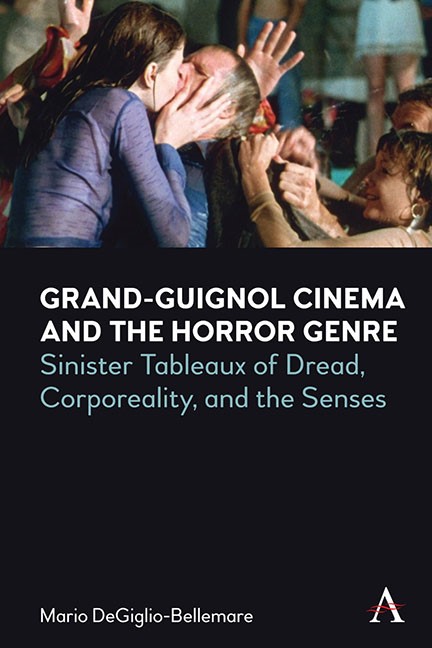Book contents
- Frontmatter
- Dedication
- Contents
- Miscellaneous Frontmatter
- Introduction: Grand-Guignol Cinema and the Senses: Eyes Without a Face, Attractions, Affect and Facial Trauma
- Chapter One The Grand-Guignol Theatre: A Short History of theTheatre and Spatial Ecologies of Dread The Hitch-Hiker and Shivers
- Chapter Two Grotesque Carnivals of “Stubborn” Aurality: Embodied Discourse in Early Talkie Horror Cinema Murders in the Rue Morgue, Freaks, and The Black Cat
- Chapter Three The Sight of Corpses in the Ruins of Modernity: Surgical Sadists under Censorship: The Body Snatcher, and Mad Love, The Blood of the Beasts
- Chapter Four Erotic Abattoirs of Bad Taste: Unproductive Potlatch in Exploitation Cinema: Fascination, Grapes of Death, and Salò, or 120 Days of Sodom
- Chapter Five French Colonial Skinning: Affect and Becoming-Wound in the Cinema of Sensation: Trouble Every Day, Sombre, and In My Skin
- Conclusion: Drag Performativity and Multisensorial Dread Blood and Black Lace and Psycho
- Bibliography
- Index
Conclusion: Drag Performativity and Multisensorial Dread Blood and Black Lace and Psycho
Published online by Cambridge University Press: 15 November 2023
- Frontmatter
- Dedication
- Contents
- Miscellaneous Frontmatter
- Introduction: Grand-Guignol Cinema and the Senses: Eyes Without a Face, Attractions, Affect and Facial Trauma
- Chapter One The Grand-Guignol Theatre: A Short History of theTheatre and Spatial Ecologies of Dread The Hitch-Hiker and Shivers
- Chapter Two Grotesque Carnivals of “Stubborn” Aurality: Embodied Discourse in Early Talkie Horror Cinema Murders in the Rue Morgue, Freaks, and The Black Cat
- Chapter Three The Sight of Corpses in the Ruins of Modernity: Surgical Sadists under Censorship: The Body Snatcher, and Mad Love, The Blood of the Beasts
- Chapter Four Erotic Abattoirs of Bad Taste: Unproductive Potlatch in Exploitation Cinema: Fascination, Grapes of Death, and Salò, or 120 Days of Sodom
- Chapter Five French Colonial Skinning: Affect and Becoming-Wound in the Cinema of Sensation: Trouble Every Day, Sombre, and In My Skin
- Conclusion: Drag Performativity and Multisensorial Dread Blood and Black Lace and Psycho
- Bibliography
- Index
Summary
Large abstract blueish orbs fill the screen as a distinctive contemporary jazz-inflected beat invades the soundtrack. Splashes of purple intermingle with the blue orbs as the images become indiscernible and take on a feeling of aliveness. The music gives flesh to the abstract images, creating a contextual resonance with time and place. Upon a closer look, these abstract images embody the materiality of the fashion industry: colours, clothes, textures, mannequins, people and place. This is the opening of Mario Bava’s Blood and Black Lace/6 Donne Per L’Assassino (1964). The opening credit sequence reminds just how performative music is, and that indeed it is often the main character in a genre like the Italian giallo—a genre that Bava is often credited with creating. In Blood and Black Lace, Bava’s second giallo, the music and fashion house setting combine to make something that is very contemporaneously queer. I have spiraled back to the early 1960s to end this study of Grand-Guignol cinema, eschewing linear readings of films in this lineage and instead championing some monstrously queer ones.
This is not the first discussion of music in Grand-Guignol cinema in this text; I discussed the place of jazz in cinematic themes of race in the 1930s US in Chapter 2. As discussed in that chapter, focus on sound need not depoliticise. The jazz under discussion here in Blood and Black Lace, written by the prolific Italian composer, Carlo Rustichelli, resonates with an intense contemporaneity of the 1960s. Its rhythm betrays influence of Brazilian bossa nova, popular all over the West at the time. Thinking through a film’s score is part of reading a film through the corporeal and sensorial. Such readings give materiality to representational readings that tend to reinforce dichotomous thinking. In the relational event of affective cinema viewership, one is thinking-feeling in a productively embodied way. In affective viewership, then, questions of race, class, gender and sexuality are not bypassed, but materially fleshed-out. In this Conclusion, I will draw out the theme of sexuality intersectionally in relation to a critique of capitalism—and of course always in relation to the corporeal. Bava’s film is set in the fashion industry after all.
- Type
- Chapter
- Information
- Grand-Guignol Cinema and the Horror GenreSinister Tableaux of Dread, Corporeality and the Senses, pp. 215 - 228Publisher: Anthem PressPrint publication year: 2023

